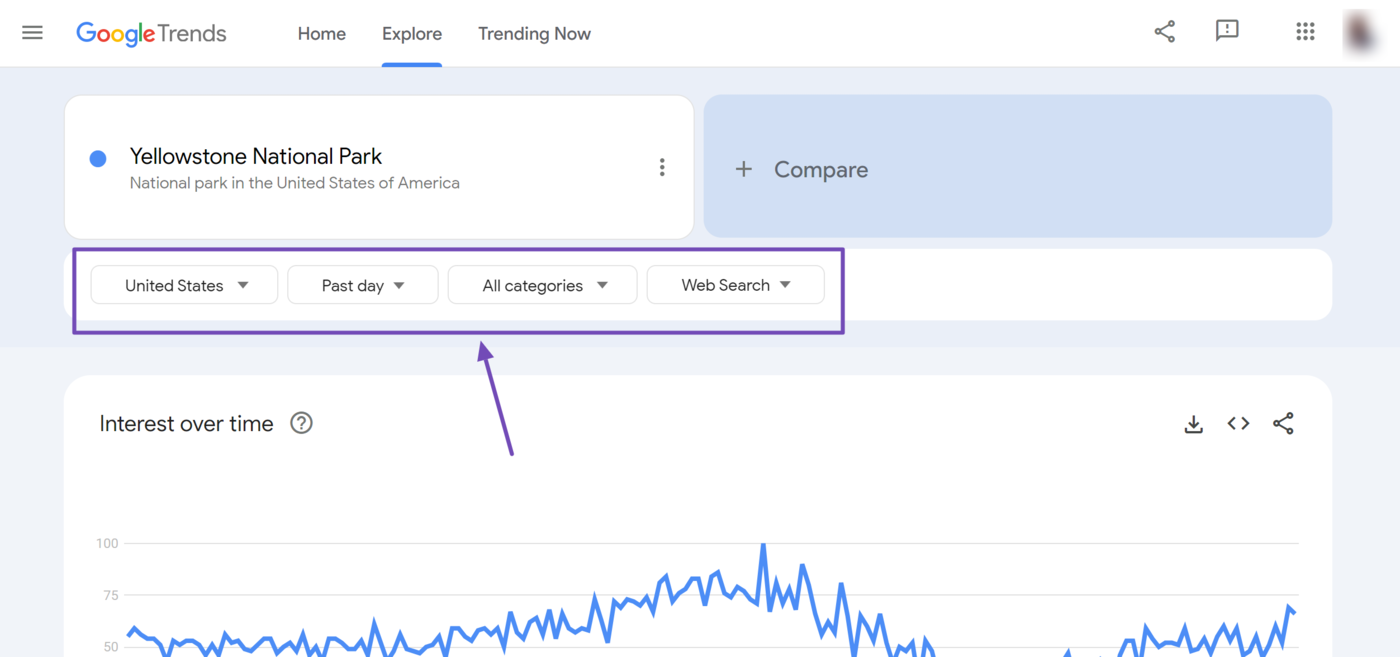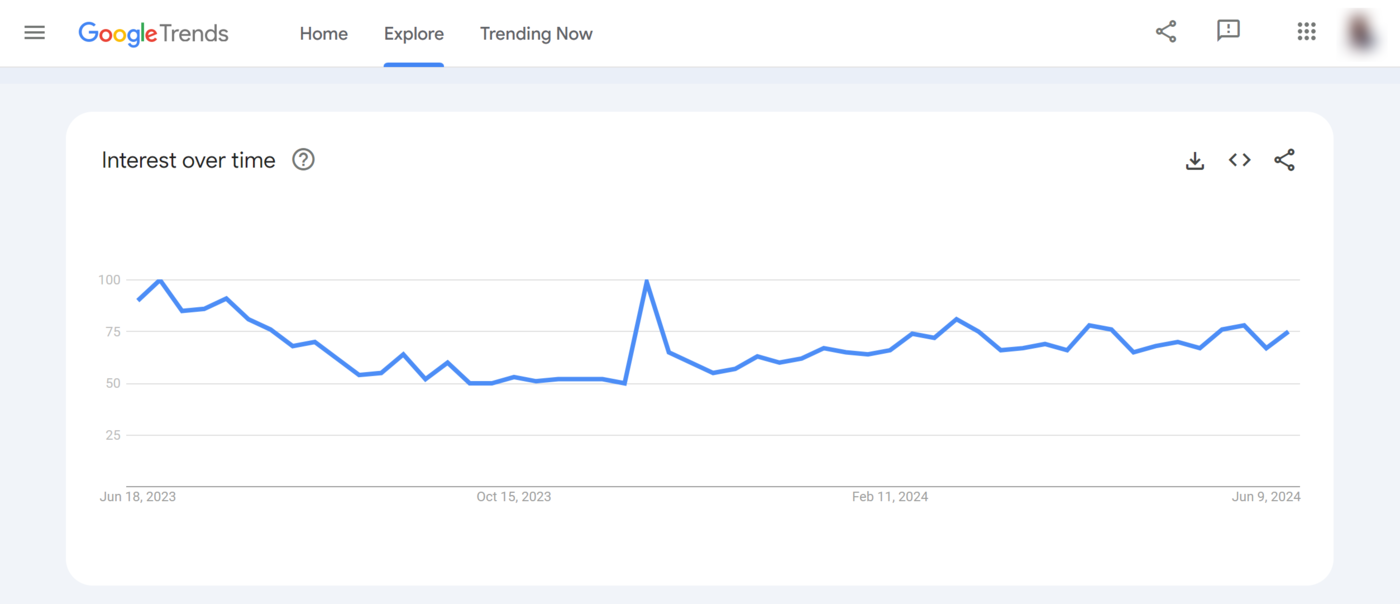Mikä Google Trends on?
Google Trends on ilmainen työkalu, jonka avulla käyttäjät voivat analysoida hakukyselyn suosiota ajan mittaan. Se tarjoaa oivalluksia siitä, mitä ihmiset etsivät ja kuinka kiinnostus tiettyihin aiheisiin muuttuu ajan myötä.
Google Trends on Googlen omistama, ja se kerää tietojaan hakukyselyistä, joita tosielämän käyttäjät tekevät Google-hakuun.
Google Trendsin käyttötavat
Google Trends on monipuolinen työkalu, jota voidaan käyttää eri tarkoituksiin eri aloilla. SEO:t ja markkinoijat käyttävät sitä kuitenkin usein avainsana- ja markkinointitutkimukseen.
1 Avainsanatutkimus
Bloggaajat, vloggaajat, SEO:t, sosiaalisen median johtajat ja sisällöntuottajat käyttävät Google Trends -palvelua löytääkseen trendikkäitä hakutermejä ja aiheita. Näin he voivat tunnistaa potentiaaliset avainsanat, joita he voisivat sisällyttää uuteen tai olemassa olevaan sisältöön.
2 Markkinatutkimus
Yritykset ja markkinoijat käyttävät Google Trends -palvelua saadakseen tietoa kuluttajien käyttäytymisestä ja markkinatrendeistä. Tämä auttaa tunnistamaan nousevat trendit, seuraamaan brändin kuntoa ja tekemään dataan perustuvia päätöksiä, joiden avulla he voivat pysyä kilpailijoidensa edellä.
Tietojen analysoiminen Google Trendsin avulla
Google Trends on intuitiivinen käyttää myös ihmisille, joilla ei ole kokemusta tietojen käsittelystä. Alla näytämme, kuinka voit käyttää sitä avainsanojesi analysointiin ja vertailuun.
1 Avainsanan syöttäminen Google Trendsiin
Ensimmäinen, siirry Google Trends -työkaluun ja kirjoita avainsanasi käytettävissä olevaan kenttään. Jos sisältö on tarkoitettu asuinmaasi ulkopuoliselle yleisölle, voit valita maan sivun yläreunassa olevasta avattavasta valikosta.
Kun olet valmis, napsauta Tutkia.

Google Trends palaa sivulla, joka sisältää avainsanasi tiedot.

2 Graafin ymmärtäminen
Google Trends -tulostyökalun yläosassa on kaavio. Tämän kaavion avulla voit nopeasti tunnistaa kuviot, jotka osoittavat avainsanan suosion nousun ja laskun.
Kun viet hiiren osoittimen kaavion päälle, näet työkaluvihjeen, joka tarjoaa lisätietoja avainsanasta.

Katso nyt kaavion vasenta puolta. Huomaat sarjan numeroita, jotka nousevat ylöspäin 100.

Näitä lukuja kutsutaan korkopisteiksi. Ne eivät edusta absoluuttista hakujen määrää. Sen sijaan ne näyttävät, milloin avainsana oli haetuin ja vähiten haettu.
100 osoittaa termin huippusuosion. Toisin sanoen täällä Googlen käyttäjät hakevat avainsanaa eniten.
Samaan aikaan nolla tarkoittaa, että termille ei ollut tarpeeksi tietoa. Tämä voi tarkoittaa erittäin alhaista hakukiinnostusta tai ei lainkaan hakukiinnostusta tiettynä aikana ja paikassa, tai hakujen määrä oli niin alhainen, että se ei ollut tarpeeksi merkittävä esitettäväksi kaaviossa
3 Suodattimien käyttäminen tarkemmille tiedoille
Google Trends tarjoaa useita vaihtoehtoja sinulle näytettävien tietojen muokkaamiseen. Jotkut näistä vaihtoehdoista ovat kaavion yläosassa. Sieltä löydät neljä avattavaa valikkoa, joiden avulla voit muokata näkyvää hakukyselyä niiden mukaan:
- Alue
- Aikajana
- Luokka
- Hakutyyppi

Alue – Avattavasta aluevalikosta voit valita alueen, josta haku on peräisin. Tämän avulla voit määrittää, kuinka paljon kiinnostusta avainsanasi sai kyseiseltä alueelta.
Aikajana – Aikajanan pudotusvalikon avulla voit määrittää päivämäärät, jolloin ihmiset hakivat kyseisellä avainsanalla. Voit asettaa mukautetun päivämäärän tai valita yhden ennalta määritetyistä päivämäärävaihtoehdoista.
Luokka – Luokka-pudotusvalikon avulla voit suodattaa hakutiedot hakijoiden kiinnostuksen kohteiden mukaan. Tämä ominaisuus auttaa rajaamaan hakukyselyitä, varsinkin kun ne sisältävät avainsanoja, jotka jakautuvat eri luokkiin.
Hakutyyppi – Hakutyyppi-pudotusvalikon avulla voit suodattaa hakutiedot hakutyypin mukaan. Se on asetettu näyttämään verkkohakutuloksia oletuksena, mutta vaihtoehtoja on valita Kuva, Uutiset, Google Shopping ja YouTube-haku.
Muut Google Trendsissä näkyvät tiedot
Google Trends näyttää joitain muita tietoja kaavion alla olevissa osioissa. Nämä lisätiedot sisältävät:
- Kiinnostus alueen tai osa-alueen mukaan
- Aiheeseen liittyviä aiheita
- Aiheeseen liittyvät kyselyt
1 Kiinnostus alueen tai osa-alueen mukaan
Kiinnostus alueittain -osiossa näyttää avainsanan suosion maittain.

Jos haku on rajoitettu johonkin maahan tai alueeseen, se merkitään sen sijaan "Kiinnostus osa-alueen mukaan" ja näyttää avainsanojen suosion maan osavaltioiden tai alueiden mukaan.

Näytetty kartta on värikoodattu. Mitä sinisempi alue, sitä enemmän hakukyselyitä tuli kyseiseltä alueelta. Samaan aikaan alueet, joilla on vähän tai niitä ei ole ollenkaan, näkyvät harmaina.

Voit kuitenkin napsauttaa alareunassa olevia nuolia navigoidaksesi kartalla näkyvillä alueilla tai osa-alueilla.
![]()
Voit myös käyttää osion yläreunassa olevaa avattavaa Alue/seutualue-valikkoa tarkastellaksesi alueen tai osa-alueen tiettyjen alueiden hakuraportteja.

Jos hakutiedoksi on asetettu "Maailmanlaajuinen", voit valita seuraavista Alue ja Kaupunki.

Jos hakutiedot on asetettu tiettyyn maahan, voit valita jonkin niistä Seutukunta, Metro, tai Kaupunki.

2 Aiheeseen liittyvät aiheet
Aiheeseen liittyvät aiheet -osiossa näkyvät hakutermit, joita myös hakijat ovat tehneet hakiessaan Google Trendsiin kirjoittamaasi avainsanaa. Osion yläosassa on pudotusvalikko, josta voit valita Nousemassa ja Yläosa.

Nousemassa – Tämä osoittaa hakuaiheet, joita parhaillaan haetaan hakutermin rinnalla. Nämä hakutermit näyttävät prosenttipistemäärän, joka osoittaa, kuinka usein hakijat tekevät hakuja molemmilla termeillä.
Ne voivat myös näyttää "Breakout" mikä osoittaa, että heillä on tällä hetkellä erittäin korkea hakutaajuus.
Yläosa – Top näyttää suosituimmat hakuaiheet ajan mittaan. Nämä tiedot sisältävät yleensä osuvuuspisteet, jotka osoittavat, kuinka yleistä on, että hakijat hakevat niitä avainsanasi rinnalla.
Mitä korkeammat osuvuuspisteet ovat, sitä yleisemmin hakijat hakevat sitä avainsanasi rinnalla.

3 Aiheeseen liittyvät kyselyt
Aiheeseen liittyvät kyselyt -osiossa näkyvät hakukyselyt, joita hakijat tekevät hakukyselyn lisäksi tai sen sijaan. Osiossa on myös pudotusvalikko, joka sisältää kaksi vaihtoehtoa: Nousemassa ja Yläosa.

Useiden termien vertailu
Google Trendsin avulla voit vertailla useita hakutermejä. Voit tehdä sen Trends-etusivulla erottamalla avainsanat pilkulla.

Kun olet valmis, Google Trends näyttää sinulle useita värikoodattuja kaavioita sen mukaan, kuinka monta hakutermiä syötit työkaluun.

Voit halutessasi kirjoittaa lisää hakulausekkeita napsauttamalla Vertailla kenttään ja kirjoittamalla hakukyselyyn.

Tämän jälkeen voit jatkaa avainsanojesi vertailua. Saatat kuitenkin huomata pieniä muutoksia, kun vertaat useita hakukyselyitä Trends-työkalulla.
Esimerkiksi Liittyvät aiheet -osio ei ole enää käytettävissä. Tämä on normaalia. Muita vaihtoehtoja on kuitenkin saatavilla ja ne toimivat edelleen normaalisti.
Google Trendsin käyttäminen SEO:lle
Google Trends on arvokas työkalu SEO:lle. SEO:t, bloggaajat ja sisällöntuottajat käyttävät sitä eri tarkoituksiin, mukaan lukien:
- Arvokkaiden avainsanojen tunnistaminen
- Paikallisen SEO-strategian kehittäminen
- Hyödynnä kausitrendejä
- Erottaa trendit ja muotit
1 Arvokkaiden avainsanojen tunnistaminen
SEO:t käyttävät Google Trends -palvelua määrittääkseen, millä avainsanoilla sijoitetaan.
Voit tehdä tämän kirjoittamalla avainsanan Google Trendsiin. Analysoi sitten sen kaavioita johdonmukaisten kiinnostusten tai nousevien trendien varalta, jotka ovat arvokkaan ja ikivihreän avainsanan kaksi tärkeintä indikaattoria.

Osana avainsanatutkimustasi tarkistat myös aiheeseen liittyvät aiheet ja kyselyt:
- Aiheeseen liittyvät aiheet antavat sinulle käsityksen avainsanan hakutarkoituksesta
- Aiheeseen liittyvät kyselyt voivat olla hyödyllisiä sisältöön sisällytettävien toissijaisten avainsanojen ja ala-aiheiden tunnistamisessa
2 Paikallisen SEO-strategian kehittäminen
Google Trends on hyödyllinen SEO:ille, jotka haluavat tunnistaa arvokkaita paikallisia avainsanoja, joiden perusteella sijoittua. Aloita kirjoittamalla avainsanasi Google Trendsiin ja määrittämällä se kohdeyleisösi alueelle.
Siirry sitten Kiinnostus osa-alueen mukaan -kenttään tarkistaaksesi, millä alueilla avainsana on suosituin. Voit käyttää avattavaa valikkoa tarkastellaksesi avainsanan suosiota metron ja kaupungin mukaan.
Kun olet tunnistanut kiinnostavat alueet, luo sijaintikohtaiset aloitussivut kohdistaaksesi näille alueille.
3 Hyödynnä kausitrendejä
Google Trends auttaa tunnistamaan kausiluonteiset hakumallit. Tässä tapauksessa asetat aikajanan arvoon P5 vuotta sitten, 2004 - nykyhetkitai mukautettu aikajana, joka kattaa muutaman vuoden.
Tarkastele nyt dataa nopeiden nousujen ja laskujen varalta, jotka ovat kausitrendien indikaattoreita. Esimerkiksi "joululahjat" -haut alkavat olla huipussaan heinäkuussa ja jatkuvat joulukuun huippuun asti. Sitten ne putoavat jyrkästi tammikuussa.

Kausitrendit antavat SEO:lle mahdollisuuden ennakoida tiettyjen hakutermien ruuhka-aikoja ja suunnitella sisältö- ja markkinointikampanjoitaan sen mukaisesti.
4 Trendien ja muotien erottelu
Google Trends auttaa määrittämään, onko avainsana trendi vai vain uusi muoti, joka katoaa pian. Tämä on hyödyllistä, jotta et käyttäisi aikaa ja vaivaa lyhyen elinkaaren omaavan sisällön luomiseen.
Tässä tapauksessa syötät avainsanan Google Trendsiin ja seuraat sen johdonmukaisuutta muutaman vuoden ajan. Jos avainsana osoittaa jatkuvaa tai kasvavaa kiinnostusta ajan myötä, se on todennäköisesti trendi, johon kannattaa panostaa.
Kuitenkin, jos kiinnostus nousee äkillisesti ja sitten laskee, se on todennäköisesti villitys.
